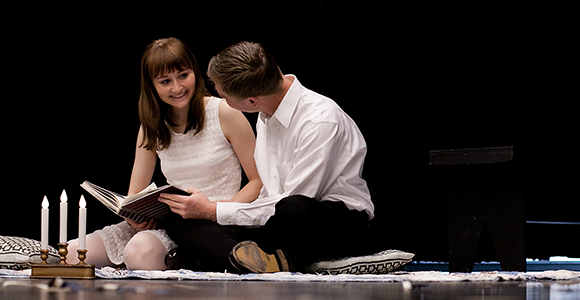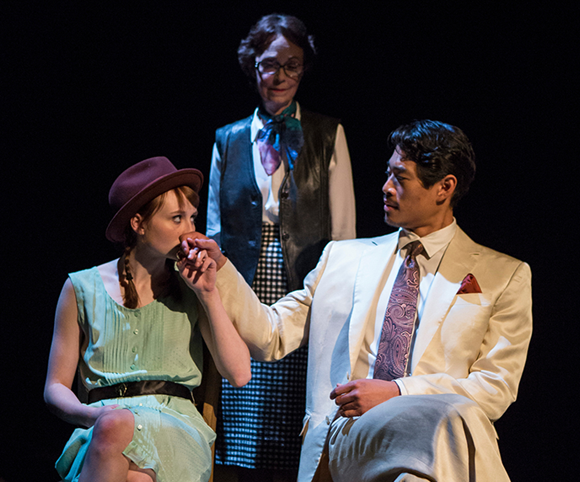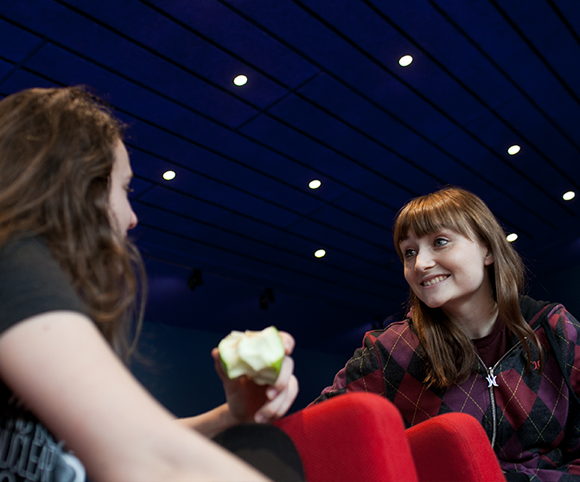
Portrait of the actress as a fourth-year
On stage and on campus, Rae Gray is someone to watch.
Elizabeth Station | Photography by Jonathan Gibby
Rae Gray—who made her first commercial at age 4 and was cast in a John Malkovich film, Drunkboat, at 14—has no memory of a life before acting. Since she enrolled in the College in 2010, the Chicago native has appeared in a professional stage production every quarter. Balancing schoolwork with an acting career is just what she does.
Local theater critics have hailed Gray as up and coming for years, but in 2013 the buzz grew louder and the work came faster. She appeared in Completeness, a romantic comedy at Chicago’s Theater Wit, from February to May. She squeezed in a trip to New York to tape back-to-back episodes of HBO’s period drama Boardwalk Empire in April, showing up two weeks late for spring quarter. She flew to Los Angeles in June to rehearse Slowgirl, a two-person play that opened in July at Chicago’s Steppenwolf Theatre.
Gray’s costar in Slowgirl, Chicago actor William Petersen, is best known for his role as head investigator Gil Grissom on CSI: Crime Scene Investigation. The pair rehearsed, performed, ate dinner, and even went to a Cubs game together during the play’s critically acclaimed run. “This was a dream,” she says.
Then one sunny August Saturday, as she and her mother walked down Michigan Avenue, they spied a giant banner unfurled above the shoppers. It featured a larger-than-life Gray embracing the leading man in her next production, The North China Lover, slated to open in September at nearby Lookingglass Theatre.
Gray snapped a picture of the banner for her Facebook page and kept moving. Slowgirl hadn’t closed yet but rehearsals for The North China Lover would begin soon. She was reading books about her character, the French writer Marguerite Duras, to prepare. Meanwhile, Gray’s fourth year as a theater and performance studies major was approaching. She planned to take playwriting, creative nonfiction writing, and 20th-century drama, and she was thinking about a topic for her BA paper.
She also wondered if she might earn independent study credit for her work preparing for and acting in professional shows. In March 2014 she and Petersen will reprise Slowgirl at the Geffen Playhouse in Los Angeles—which means spending winter quarter away from campus. “It should be possible that I’ll graduate with my class in June,” Gray said in October. “I’m still not entirely positive.”

Reviewers have called Gray enchanting, endearing, and “sublimely watchable.” In the 2010 production of Jailbait, she played a high-school girl who poses as a college student to meet older men. Chicago Sun-Times critic Hedy Weiss described her as possessing “a delicate, gamine face, a slight gawkiness, and perfect instincts.”
With pale, luminous skin, a lean frame, and a voice that can move from honking to husky, Gray’s fluid physicality is part of her appeal. As a brash 17-year-old in Slowgirl, she moved between awkward and self-assured, vulnerable and hilarious. She and Petersen—who played her uncle—had a strong and convincing rapport. Onstage she can project powerfully if a line needs to shock, or quietly hold an audience close to witness an intimate inner moment.
Offstage she comes across as grounded, using phrases like “ridiculously awesome” to describe her life and pronouncing “theater” with two syllables. Self-deprecating and funny, Gray can deliver one-liners with equal skill whether working from a script or posting on Twitter. (“You know what’s good fodder for comedy?” she tweeted last fall. “15 University of Chicago students in a Laban Movement class.”)
In The North China Lover, Gray played the teenage Marguerite Duras involved in an affair with a much older Chinese man. Some critics suggested that she was unconvincing in a difficult role, but others wrote that she captured “both the innocence and preternatural worldliness of her character” and called her “astonishing … at once childlike and an old soul.”
Growing up in Chicago’s West Loop, Gray did plays, films, commercials, and more than 100 voice-overs before age 13, often with her older brother, Zach. They had help from their mother, Dawn, a former child actor who started Gray Talent Group, an agency that represents about 300 actors including her daughter. Gray’s father, Rick, is a retired marketing executive.
Zach gave up acting to study communications at Northwestern and now works at Gray Talent Group. “Our family is very much like a little business unit,” says Gray. It is also a source of support: Gray’s 86-year-old paternal grandparents, Gloria, X’48, and Bill, U-High’43, PhB’48, MBA’50, regularly make the trek to the city to see her perform. Sometimes they bring busloads of friends from their retirement home in suburban Burr Ridge. While Gray lived in Hyde Park for her first three years of college—in Max Palevsky and later an apartment—she lived at home this past fall to save money.
Lookingglass ensemble member Heidi Stillman, who directed Gray in The North China Lover, has known her for years. “There are people coming to this show, colleagues of mine, who say, ‘Oh, I directed Rae when she was ten years old,’ or ‘I designed a set for a show of Rae’s when she was 11,’” says Stillman. “The community feels very parental toward her.”
Last summer Gray posted a pixieish 2001 photo of herself online, rehearsing A Cry of Players at TimeLine Theatre with director P. J. Powers. He wrote back, “I will never forget 8-year-old you pulling out a tooth onstage and holding it up to me as if I’d give you a prize.”
Twelve years later, her role in The North China Lover required a nude scene. “She was totally game and up for it,” says Stillman. “I was the nervous Nelly.” Gray responds, “I feel very safe onstage, so I never, ever felt nervous or uncomfortable about the nudity.”
More challenging, she says, was finding a way to embody the young Duras as a believable character and make the story, adapted from Duras’s book, come alive as a work of theater. The language is “so descriptive and evocative,” she says. “It’s sometimes hard to make a gorgeous book like that very active on stage.” She ended up feeling a kinship with Duras despite the difficulty: “We’re both writers, and we experience things for the experience,” says Gray, who is pursuing a minor in creative writing and English.

In the front row of her 20th-century drama class, casual in skinny jeans and a plaid shirt, Gray hunches with pen poised over a notebook. She’s quick to answer senior lecturer Heidi Coleman’s question—“What is nostalgia?”—in a discussion of Death of a Salesman. “Remembering very fondly the past,” she says. “Thinking about it obsessively, wishing for it again.”
When Coleman asks for volunteers to read and block scenes, the city’s most watchable actress prefers to watch. She is not interested in playing the role of That Kid. “I do participate a lot in most of my classes,” says Gray, but “I don’t want to be the obnoxious person constantly saying everything.” Besides, her classmates won’t be going to the theater that night to perform: “I’m lucky to get to say words aloud every day.”
Gray takes dance and voice classes “because it’s always good to have that in your back pocket,” but she never formally studied acting. “I have learned from watching my heroes on the stages of Chicago and working with Chicago actors,” she says.
She chose the College over an acting conservatory because she wanted to meet people, including professors, interested in fields other than theater. “Sometimes you become a much better actor by living and learning other things,” she says—like Spanish and math. “We’re recreating life on stage, so frequently what’s most helpful is experiencing that life for yourself.”
Her best friends at school are premed and social science majors—except for third-year Allison Torem, who acted with Gray in The North China Lover and transferred from DePaul to UChicago with her friend’s encouragement. Gray generally sees actors off campus, when she goes to work.
Her schedule typically reserves weekday mornings for classes. During a play, she grabs lunch on campus, catches the Green Line, and studies on the train and at home before heading to the theater. After a performance—or between shows when there are two a day—she may attempt more homework. Still, she prioritizes sleep: “There are probably 15 nights out of the year where I don’t sleep eight hours.”
One chilly October day around midterms, Gray showed up pale and tired for Coleman’s class and performed a required scene from The Glass Menagerie. She was recovering from a respiratory infection and still had to get across town for a costume fitting—she’d booked an episode on ABC’s drama Betrayal, which would shoot in Chicago the next day.
Despite the juggling, Gray earns high enough grades to make the Dean’s List. But except for a two-year stint on the Dean’s Advisory Council, she hasn’t squeezed in any extracurriculars. She has never acted in a school play, not even as a student at Chicago’s Latin School. “I don’t even know what it’s like, honestly,” she says. “I bet it’s super fun.”
More than one person has chided Gray for not studying abroad during college; her longest time away from Chicago was the three weeks she spent in Los Angeles rehearsing Slowgirl. Living at home, she sees her parents almost every day. “These have been the best three years of my life,” she says, “but I don’t think it was traditional by any means.”

She’s done a musical with Patti LuPone, played a heroin-addicted streetwalker on NBC’s Chicago Fire, and hurled eyebrow-raising expletives from the stage. But when Gray arrived late for spring quarter and teachers pressed her to talk about filming Boardwalk Empire in New York, the sudden loss of regular-student status was “a little embarrassing,” she says.
At a fraternity party Gray’s first year on campus, a guy told her that for months, he’d carried around a program from Circle Mirror Transformation—a show she’d done at Victory Gardens Theater—in case he saw her and could ask her to sign it. Theater fans in the city recognize her too. “There are just people who are randomly tuned into you very much,” she says. Last fall she stopped at Glazed and Infused, a West Loop doughnut shop, “and this woman was like, ‘You’re Rae Gray. I know you’ve done this; I know you’re a Cubs fan.’ And I’m like, ‘How do you know I’m a Cubs fan?’”
She forgets that her Twitter feed is peppered with posts about the Cubs, Bulls, and Blackhawks—although she often goes for days or weeks without updating her social media status. She dutifully posts reviews and videos on her Facebook fan page while worrying that PR “is sometimes subtle bragging.”
She admires her Slowgirl costar, mentor, and friend Petersen for eschewing e-mail and computers. He dials friends’ numbers from memory on an old flip phone. “I would love not to be on any social media,” she says. “But you have to keep up with the times.”
Entertainment is geared toward younger people, she adds, “so if the younger generation” is on social media, she needs a professional presence there. Wait a minute, isn’t Gray part of the younger generation? “I know; I get that all the time—that I’m like a 60-year-old man trapped in a 21-year-old woman’s body.” Because she grew up mostly in the company of adults, she says, she often unintentionally adopts their perspective.

When a young person chooses an arts career and shows blazing promise, the same questions, fair or not, invariably surface. Will she make it in the business? What will happen if she doesn’t? What mysterious forces will determine her success?
Stillman of Lookingglass feels sure about Gray’s future: “I always tell everyone she’s going to be a big movie star, but I hope she also keeps doing theater.” Gray has rare talent and an interesting face, and “there’s a lot going on inside her when she’s acting,” says Stillman. “The camera loves that.”
Gray’s intelligence, work ethic, and ability to see how individual scenes add up to a bigger picture are unusual in a young actor, Stillman believes. “She’s also got that drive in her that’s constantly looking for, ‘How can I get better? How can I improve? What else do I need to experience to grow in my craft?’”
Gray says she’s already encountered rejection, an actor’s frequent companion. Late in high school, she says, “I looked like I was ten, but I was five foot six and I couldn’t really play kids anymore.” She wasn’t cast in much until she turned 18 and finally looked old enough to play teenagers. If she bombs an audition, “I will spend the next couple of years making sure that I know how to do what I failed at.”
During her college search Gray tasted disappointment too. Her “whole life,” she says, her first choice was Northwestern, her mother’s and brother’s alma mater. “I dreamed about it unhealthily,” she says. “I told everyone I was going there.” Yet when she applied early decision, she did not get in. She remembers the family eating their deep-dish pizza in silence the night the rejection letter came. Later she and her brother rebounded with a basement dance party.
Gray thinks her arts background and essays made a difference when she applied to UChicago. Ending up at the College was “the best thing ever,” she says. “It’s the same thing with theater. A lot of times you’re dying to get a show and you don’t get it. And sometimes, something better ends up happening in that time slot.”
After graduation Gray hopes to work in “the three main kahunas of acting”—Chicago, New York, and Los Angeles. Intrigued by the actor-playwright combination, she’s focusing her BA paper on Steppenwolf’s Tracy Letts, who won a Pulitzer Prize for his play August: Osage County and Tony awards both for his acting and writing.
Gray calls herself a “storytelling, narrative-driven person” who has written hundreds of poems and short stories and some “not very good” plays. “I love to write, but I have to act,” she says, ideally as part of an ensemble.
She shot an indie feature, Tonight’s Special, in Chicago last month and hopes to do more film and television. While her TV roles have been small, she takes each one seriously. On Boardwalk Empire, she played a young woman who dances a drunken Charleston at a Prohibition-era party. While the main actors deliver their dialogue in the foreground, Gray flails like a wacky, silent rag doll in the margins of the shot.
It’s less a scene stealer than a reminder that as an actor, she is prepared to do the work that the scene requires, and a little more. She’s drawn us into a story. Once again, we’re watching.